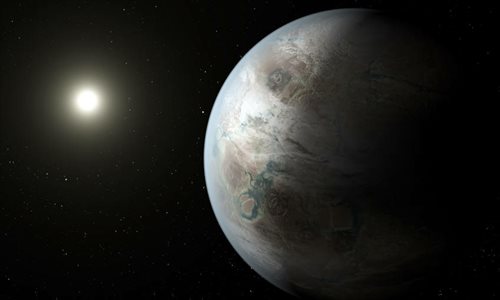

 |
| Photo: news.haiwainet.cn |
LOS ANGELES, July 23 -- Scientists using planet- hunting Kepler space telescope have discovered a new catalog of exoplanet candidates and confirmed the first near-Earth-size planet in the "habitable zone" around a sun-like star, NASA announced during a press conference Thursday.
Though NASA said it can't say for sure whether the planet is rocky like ours or has water or air, the newly discovered Kepler- 452b is the closest match yet found. Previous research suggests that planets the size of Kepler-452b have a good chance of being rocky.
"On the 20th anniversary year of the discovery that proved other suns host planets, the Kepler exoplanet explorer has discovered a planet and star which most closely resemble the Earth and our Sun," said John Grunsfeld, associate administrator of NASA 's Science Mission Directorate at the agency's headquarters in Washington. "This exciting result brings us one step closer to finding an Earth 2.0."
According to NASA, the new catalog includes 12 candidates that have diameters between one to two times that of Earth, orbiting in the so-called habitable zone of their star. This zone is the range of distances at which the energy flux from the star would permit liquid water to exist on the planet's surface.
Of these, nine orbit stars that are similar to our sun in size and temperature. Kepler 452b, about 1,400 light years from Earth in the constellation Cygnus, is the first to be confirmed as a planet of these candidates.
"This is really the first step, and humankind's first step", John Jenkins, of the SETI Institute, said at a NASA press conference. "You and I won't be traveling to these planets, but our children's children's children may."
The planet is about 60 percent bigger in diameter than Earth and is considered a super-Earth-size planet and the smallest planet to date discovered orbiting in the habitable zone -- the area around a star where liquid water could pool on the surface of an orbiting planet -- of a G2-type star, like our sun. The confirmation of Kepler-452b brings the total number of confirmed planets to 1,030.
Kepler 452b accompanies a star whose characteristics are very similar to the Sun: it is 4 percent more massive and 10 percent brighter. Kepler-452b orbits its star at the same distance as Earth orbits the Sun.
"If Kepler 452b is indeed a rocky planet, its location vis-a- vis its star could mean that it is just entering a runaway greenhouse phase of its climate history," says Doug Caldwell, a SETI Institute scientist working on the Kepler mission. "The increasing energy from its aging sun might be heating the surface and evaporating any oceans. The water vapor would be lost from the planet forever."
"This discovery and the introduction of 11 other new small habitable zone candidate planets mark another milestone in the journey to finding another 'Earth'", NASA said in a statement.
The discovery of Kepler-452b is substantial but it's not the first of its kind. Last year, astronomers announced the first Earth-sized exoplanet, Kepler-186f, found orbiting in a star's habitable zone. The main difference between Kepler-186f and Kepler- 452b is their host stars. Kepler-186 is a red dwarf whereas Kepler- 452 is much more closely related to our Sun.
With a new release of the seventh Kepler planet candidate catalog on Thursday, the catalog of exoplanet candidates adds 521 new possible planets to the 4,175 already found by the famed space- based telescope.
The Kepler spacecraft was launched in 2009 and is NASA's first mission capable of detecting Earth-size planets around stars like our sun. So far, the spacecraft has found 4,696 exoplanet candidates, and follow-up observations and analysis have confirmed 1,030 of these candidates to exist. Through the combined efforts of Kepler and other astronomers we know of 1,927 exoplanets out there in the cosmos.
 China-made special vehicles in exhibition
China-made special vehicles in exhibition Soldiers serving at Liaoning aircraft carrier
Soldiers serving at Liaoning aircraft carrier Bikini beauties lifeguards in river rafting place
Bikini beauties lifeguards in river rafting place PLA soldiers eat raw snake meat in harsh training
PLA soldiers eat raw snake meat in harsh training Kiss contest held in Nanning, SW China
Kiss contest held in Nanning, SW China Yunnan-Myanmar Road: The past and present
Yunnan-Myanmar Road: The past and present Photos of beautiful policewoman become online hit
Photos of beautiful policewoman become online hit Campus belle of Xiamen University gets popular online
Campus belle of Xiamen University gets popular online Eight fruits that defend men's health
Eight fruits that defend men's health  Did the "Spartan" publicity stunt cross the line?
Did the "Spartan" publicity stunt cross the line? Sydney police that let mob attack consulate failed to do their duty
Sydney police that let mob attack consulate failed to do their duty 'Model fisherman' reel in tourist yuan in Guilin
'Model fisherman' reel in tourist yuan in Guilin Shady Chinese contraceptives also found exported abroad
Shady Chinese contraceptives also found exported abroadDay|Week